
Investor Spotlight - Decisive Point


NAME: Tommy Hendrix, Managing Partner
COMPANY: Decisive Point
FOUNDED: 2018
HEADQUARTERS: New York, NY
TECHNOLOGY VERTICALS FOCUS: Defense, Energy, and Infrastructure
PREFERRED ROUNDS: Seed, Series A
CHECK SIZE: $500,000 - $1.5 million
NOTABLE INVESTMENTS: Radiant, Maybell Quantum, Firestorm, Pison, and Flightwave
Background:
Tommy Hendrix is the Managing Partner of Decisive Point Group, a venture capital firm investing in defense, energy, and infrastructure. Prior to founding Decisive Point, he began his career in the private sector at Blackstone, the world's largest alternative asset management firm. Tommy is a former Green Beret with multiple combat deployments in support of the Global War on Terror; he served in the Army for nearly 10 years as an Infantry and Special Forces Officer. He earned a Masters in Business Administration from Columbia Business School, a Masters in Study of Law in Government Procurement Law from The George Washington University Law School, and a Bachelor of Science in American Legal Systems from the United States Military Academy at West Point.
Q: You come from a non-traditional background for most early-stage venture investors. What led you to founding Decisive Point? What was the unique space in the venture ecosystem that you saw Decisive Point could fill?
I spent 10 years in the Army, most of which was as a Special Forces Officer. On my final deployment in 2014, we were among the first units to return to Iraq to reconstitute US support of the Iraqi Special Operations Forces as ISIS approached Baghdad. We leveraged off-the-shelf commercial technology to facilitate dozens of air strikes against ISIS positions. We did not have our own organic tools to deliver kinetic effects so we had to build them with gear we bought from local markets. We were basically building targeting tools with gear we bought from local markets and using it to deliver kinetic effects because we did not have organic capabilities to remotely deconflict fires in complex urban environments. I had an intimate understanding of the need for new tech for the operator — and for operator input in its design and employment. When I left the military, I attended business school and landed a role at Blackstone — an amazing firm and a great place to learn from some of the best investors in the world. After a few years there, however, I wanted to get back into defense. I had an interest in venture capital and eventually left to start working with startups with the aim of helping them navigate the government — I was very fortunate to meet my co-founder, Eric Horan, at that time. Eric had worked as a GS-15 Contracting Officer for the Navy and had managed several major weapons systems programs. He had intimate knowledge of the federal procurement systems and was able to add tremendous value to our portfolio. We were joined by our third General Partner, Andrew Price, and launched our first dedicated fund. When we started, the defense innovation ecosystem was in its infancy. AFWERX had just started up, the Defense Innovation Unit was still experimental, and NSIN was called “MD5”. There were very few venture capitalists (VCs) willing to invest in defense and most other VCs I knew warned me that defense was not an area they would ever invest in. A lot has changed since then, but we’ve maintained our focus of providing direct support to companies in government contracting as the core of our investment thesis.
Q: Traditionally, investors have shied away from startups in the defense and government sectors. But a number of new funds focused on national security and deep tech have launched in the last few years, and several other established funds have carved out a focus on national defense. What do you think is driving this growth?
Decisive Point was investing in defense before it was cool. While private equity has invested in the industry for many years, many venture capital funds really started to pivot into the space in the last 18-24 months. This has been driven by geopolitical factors that are nearly impossible for even traditional commercial technology investors to ignore, such as the war in Ukraine, increasing threats from China, and deglobalization. In 2021 and the beginning of 2022, macroeconomic conditions – which coincided with these geopolitical outbreaks – led to a massive influx of capital into VC investments. We have also seen a heroic effort to adapt from inside the government and Department of Defense, with organizations allocating significant amounts of money and standing up programs to attract new technology innovations.
Q: In addition to investing, Decisive Point provides a number of strategic services to startups primarily focused on government acquisitions. How do those services fit into Decisive Point’s investment thesis?
Decisive Point operates with an incredibly unique model in that our team works very closely with each portfolio company to guide their government acquisitions strategy. Our team effectively functions as a bolt-on government relations team, handling all of the complicated and painful parts of doing business with the government so that the companies can focus on growing and the technology. With this model and these services, we are able to provide significant value to the companies while effectively de-risking our investments by helping them win consistent revenue, which smooths out the bumps that startups often experience.
Q: What is most important to Decisive Point when assessing an investment opportunity in a dual-use focused startup?
Our commitment to investing in defense and government focused technologies runs deep. In recent months, “dual-use” has become somewhat of a VC buzzword; however, while commercial traction is important in de-risking investments from the long federal procurement cycles, there are some very important problems worth solving that are unique to defense and government. Decisive Point does not require all of our investments to be dual-use and we are also willing to invest in kinetic solutions (military weapon systems). When assessing a defense startup for investment viability, we are looking for technologies for which there is a clearly defined, recognized critical need within the government. There should be demand signals from programs with large procurement budgets and the technology should be capable of shifting a paradigm, either drastically improving on existing systems or introducing new deterrent-level capabilities.
Q: A constant challenge for dual-use startups that are raising capital is demonstrating sufficient DoD customer interest to justify an investment. What level of DoD customer interest is necessary to demonstrate real growth potential for Decisive Point to consider investing?
The Department of Defense is a massive organization with many different missions and requirements. This makes it very difficult for commercial companies to easily interpret customer demand. It is not a single buyer or decision maker that is going to unlock the entire DoD enterprise and the process is further complicated by things like requirement generation, mission prioritization, program integration, Congressional authorization and appropriations, and “colors of money”. In short, not all customers are created equal and neither are a company’s existing government contracts. We spend a lot of time unpacking a startup’s opportunity to scale in the federal market before making an investment decision.
Q: Decisive Point has supported a number of early-stage, dual-use companies through the NSIN Propel program. The Propel Hawaii program just wrapped up and the next Propel New York program is getting ready to launch. What makes you the most excited working with these companies?
NSIN Propel continues to create groundbreaking new opportunities for both our DoD mission partners and critical early-stage ventures, expanding the DoD’s access to the critical technology in the venture capital community while helping cutting-edge startups transform their technology to fulfill critical capabilities. NSIN Propel companies are mission driven and come into the program eager to address our nation’s greatest challenges. It is always exciting to help cultivate those connections and create experimentation opportunities between the companies and the end-users that need their technologies the most; encouraging technology exchange that ultimately benefits both startups and the broader DoD apparatus.
Q: How does the Propel program improve a company’s likelihood of succeeding in growing dual-use businesses?
Propel accelerates technology to market and mission with the guidance of mentors from the commercial sector, academia, private capital, and DoD partners. Throughout the program, cohort members collaborate with each other to bring new capabilities to bear, strengthen their own understanding of customer needs, pursue experimentation opportunities, and build their teams into a viable dual-use business. The result is a small business that is much more prepared to work with the DoD and succeed in the commercial market. Each program culminates in a demo day where the startups show their progress to prospective customers and private sector investors, many of whom go on to champion them in contracting opportunities or make investments.
Q: Decisive Point has invested in several Propel alumni like Asylon, Pison, Pendulum and SCOUT. What makes companies who have participated in the program more attractive as investment opportunities?
The NSIN Propel accelerators serve as a great springboard for companies to either begin engaging with government customers or accelerate their existing strategies. Given that the NSIN Propel programing brings together critical government and industry stakeholders who provide feedback and unique insights, the cohort companies leave the program with valuable connections, contracting strategies, and a cohesive plan to further their government lines of business, which are all factors that we look for when making an investment.
Q: What are some of the biggest wins you’ve seen from Propel alumni?
Across the last two NSIN Propel NYC cohorts alone, companies raised over $98 million in private capital and were awarded over $25 million in government contracts. If Demo Day was any indication, the NSIN Propel Hawaii cohort is poised to meet if not exceed those numbers as well.